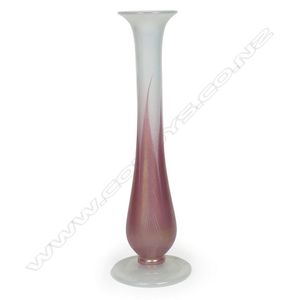Tiffany Peacock Feather Vase
A Louis Comfort Tiffany favrile specimen vase, tall elegant baluster form with golden red peacock feathers over the opalescent body. engraved marks and numbers 1502 - 7574, height 25.3 cm.
You must be a subscriber, and be logged in to view price and dealer details.
Subscribe Now to view actual auction price for this item
When you subscribe, you have the option of setting the currency in which to display prices to $Au, $US, $NZ or Stg.
This item has been sold, and the description, image and price are for reference purposes only.
- Favrile - Favrile glass is a type of iridescent art glass, similar to some of the Roman glass that has been excavated after being buried for centuries. It was developed by Louis Comfort Tiffany in 1892, patented in 1894 and the first itmes were produced in 1896. It differs from most iridescent glasses because the colour is ingrained in the glass itself, instead of being sprayed onto the surface while the glass was molten, as with Carnival glass.
The most common items manufactured by Tiffany in favrile glass were vases.
The glass was imitated by Loetz and other Bohemian manufacturers. - Opalescent / Opaline - The descriptions of glass as "opalescent" or "opaline" are often used interchangeably by dealers and auction houses. At the upper end of the scale, opalescent / opaline glass can refer to the opal-like milky blue glass produced by Lalique and Etling. It also refers to the pressed glass mass produced in Britain from the 1840s with a milky white edge as sugar-basins, milk jugs and vases were made in great quantities for the mass market, and were sold at fairs along with Staffordshire figures and wooden dolls. A less common type of opalescent glass was made from two layers of glass blown into a mould.
- Baluster (glass) - An architectural term for a column in a balustrade or staircase.
When used to describe glass, it can either refer to the shape of the stem of a wine glass, being slender above and pear shaped below, or the shape of the whole vessel, usually a vase. In fact the baluster shape is often described as being vase-like.
The description of a vase as being of baluster shape covers a wide variety of shapes that often bear no resemblance to the original architectural form. - Engraved Glass - The method of decorating glass by marking the surface with a sharp intrument such as a diamond, metal needle or rotating cutting wheel. As pressure is applied to the surface, best results for engraving are achieved if the glass is of sufficient thickness. In the 19th century etching was used to decorate some table glassware that was too fine to take an engraving tool.
This item has been included into following indexes:
